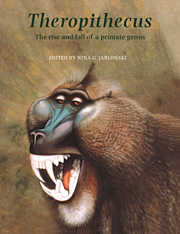Book contents
- Frontmatter
- Contents
- List of Contributors
- Preface
- Acknowledgements
- 1 Introduction
- PART I Fossil evidence and phylogeny
- 2 Theropithecus darti from the Hadar Formation, Ethiopia
- 3 Evolution of Theropithecus in the Turkana Basin
- 4 Are Papio baringensis R. Leakey, 1969, and P. quadratirostris Iwamoto, 1982, species of Papio or Theropithecus?
- 5 Theropithecus fossils from Africa and India and the taxonomy of the genus
- 6 Theropithecus from Ternifine, Algeria
- 7 The Phylogeny of Theropithecus
- PART II Biogeography and evolutionary biology
- PART III Anatomy of the fossil and living species of Theropithecus
- PART IV Behaviour and ecology of living and fossil species of Theropithecus
- Appendix I A partial catalogue of fossil remains of Theropithecus
- Appendix II Conservation status of the gelada
- Index
3 - Evolution of Theropithecus in the Turkana Basin
Published online by Cambridge University Press: 11 November 2009
- Frontmatter
- Contents
- List of Contributors
- Preface
- Acknowledgements
- 1 Introduction
- PART I Fossil evidence and phylogeny
- 2 Theropithecus darti from the Hadar Formation, Ethiopia
- 3 Evolution of Theropithecus in the Turkana Basin
- 4 Are Papio baringensis R. Leakey, 1969, and P. quadratirostris Iwamoto, 1982, species of Papio or Theropithecus?
- 5 Theropithecus fossils from Africa and India and the taxonomy of the genus
- 6 Theropithecus from Ternifine, Algeria
- 7 The Phylogeny of Theropithecus
- PART II Biogeography and evolutionary biology
- PART III Anatomy of the fossil and living species of Theropithecus
- PART IV Behaviour and ecology of living and fossil species of Theropithecus
- Appendix I A partial catalogue of fossil remains of Theropithecus
- Appendix II Conservation status of the gelada
- Index
Summary
Summary
The Turkana Basin provides a unique and relatively continuous record of part of the evolution of two extinct lineages of Theropithecus. Representatives of the T. brumpti lineage are found in deposits ranging in age from approximately 3.5 to 2.0 Ma. T. oswaldi replaces T. brumpti after 2 Ma as the common cercopithecoid in the later part of the Koobi Fora Formation. The two species are found in contemporary deposits only in the Shungura Formation between Units E-3 and G-12 (approximately 2.4 to 2.0 Ma).
Compared with later material, the early T. brumpti specimens are smaller and have less complex molar teeth, they lack a reversed curve of Spee and expanded flaring zygomatic arches, and they have less developed maxillary and mandibular corpus fossae, mental ridges and mental rugosity. All these features are more progressively developed in the later specimens from the lower Omo Valley. The T. brumpti lineage includes specimens previously referred to T. baringensis and T. quadratirostris. Two subspecies of T. brumpti are now recognized: T. b. baringensis for plesiomorphic material from earlier horizons and T. b. brumpti for apomorphic material from later horizons. Specimens of intermediate evolutionary status are referred to T. brumpti subspecies indeterminate.
[…]
- Type
- Chapter
- Information
- TheropithecusThe Rise and Fall of a Primate Genus, pp. 85 - 124Publisher: Cambridge University PressPrint publication year: 1993
- 34
- Cited by



